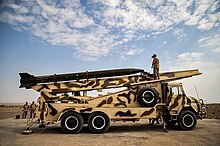|
Naze'at
The Naze'at 6-H and Naze'at 10-H/Mushak-120/Iran-130[2] (Persian: نازعات lit. Those Who Pull Out, in reference to the angels who tear out the souls of the wicked) are two Iranian long-range artillery rockets with ranges of about 100 km. The Naze'at 10-H is larger, more powerful, and has a longer range than the Nazeat 6-H. Like Iran's similar shaped Zelzal rockets, Naze'at rockets do not have a guidance system. Both systems are also widely known without the -H suffix, as the Naze'at 6 and Naze'at 10. The Iranians also have developed another 500 kg version called the Mushak-160 with 160 km range.[2] HistoryThe Naze'at family was developed during the 1980s with Chinese assistance in an attempt to build an equivalent of the FROG-7 missile.[3] Specifications
DetailsThe Naze'at is launched from a transporter erector launcher (TEL) and carries a conventional warhead, and potentially a chemical or biological one.[6] A complete Naze'at system includes a TEL and communications vans, meteorological vans, and a GPS system for surveying the launch site.[6] Both Naze'at rockets have a closing speed of Mach 4–5.[6] The reliability and accuracy of Naze'at rockets is assessed as poor.[6] The Naze'at has fins for stabilization in flight and is believed to have a CEP of around 500–1000 m, which is considered poor.[3] There are multiple different TELs used for Naze'at rockets.[3] OperatorsSee also
References
|
||||||||||||||||||||||||||||
